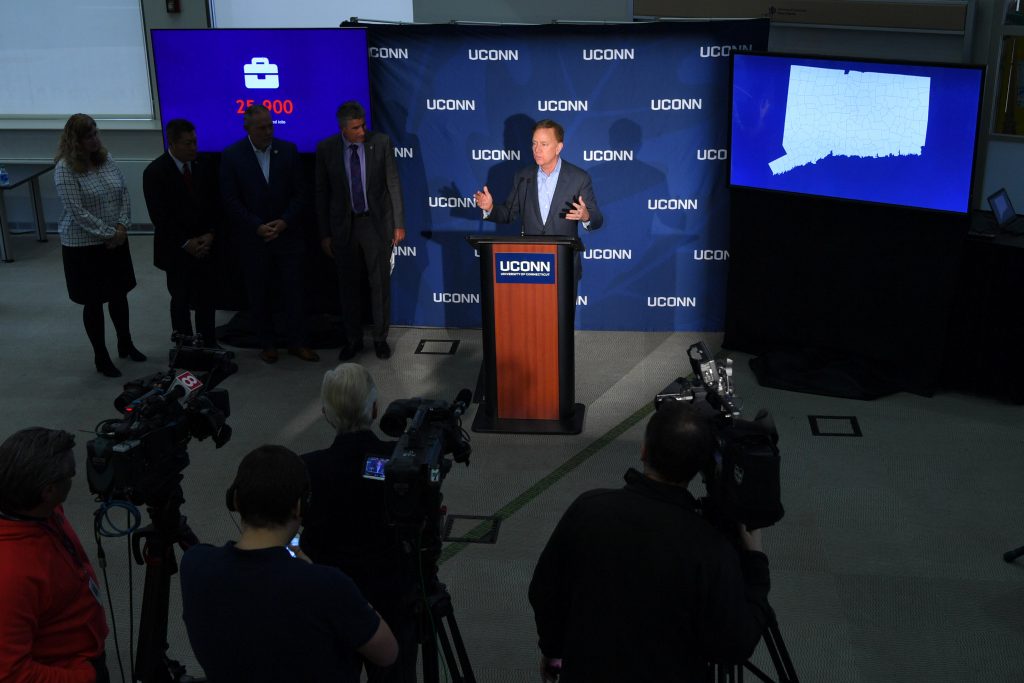The University of Connecticut generates about $5.3 billion worth of economic activity for the state, including nearly 26,000 jobs and $277.5 million in state and local tax revenue through industries that benefit from UConn’s enterprise, according to a new analysis.
The report, which UConn released Tuesday, provides a comprehensive measurement of the economic value the University provides to Connecticut through direct and indirect employment, clinical care, and numerous other research, academic, and service activities at its campuses statewide.
For every dollar spent by UConn, about 77 cents in economic output is generated elsewhere in the Connecticut economy — or about $1,500 per state resident – based on the positive effects that cascade throughout the state’s businesses, communities, and families, the analysis found.
“Effectively measuring UConn’s contributions allows us to demonstrate key aspects of the value the university brings to the state and its people,” UConn President Thomas C. Katsouleas said.
“UConn is part of a constellation of public higher education institutions in Connecticut, and they all bring great value. But as the sole public flagship research university in the state, we have an enhanced responsibility to contribute to our economy and to our communities.
“Given that, the citizens of Connecticut and their elected representatives should have a clear picture of what the return on their investment in UConn is, including with respect to our economic impact, among many others,” he said.
The full report and related documents can be found at impact.uconn.edu.
In addition to the report, that site also provides interactive features demonstrating UConn’s reach by county and in each of the state’s 169 municipalities.
That information includes the number of alumni and students in each town and city; UConn Health medical and dental patient visits by each communities’ residents; the average financial aid funded by the state and UConn per student there; and the number of UConn employees who live in each location.
Katsouleas and other UConn officials shared the report Tuesday at an event with Gov. Ned Lamont, legislators, business leaders, and others at UConn’s Graduate Business Learning Center in downtown Hartford.
The university conducted the study by determining UConn’s direct impacts – employment, equipment purchases, support of goods and services – and combining them with the indirect and induced impacts created by spending from businesses and households as a result of UConn-generated activity.
“UConn is an important engine of Connecticut’s economy,” the report says. “Overall, UConn’s impact on statewide output amounted to nearly $1,500 per state resident, attesting to UConn’s importance to the economy and its key role as an economic driver and job creator.
“In addition, UConn is leading the way into a knowledge-based economy with investments in the education of a modern labor force, cutting-edge research, and high quality performing arts — all of which enhance the quality of life of Connecticut residents,” the report says.

According to the analysis, UConn’s $5.3 billion impact on statewide economic output includes $3 billion generated directly by the University, and from spillover effects on other affected industries ($914 million) and households ($1.4 billion).
About $2.6 billion of the economic impact was generated by activity at UConn Storrs, plus another $2.2 billion at UConn Health. The four regional campuses – Stamford, Hartford, Waterbury and Avery Point – also provide a $383 million benefit to the state’s economic output.
UConn’s economic impact is expected to continue growing in coming years as it focuses heavily on research and innovation, and in the continuing evolution and success of the Next Generation Connecticut initiative, the partnership with Jackson Lab at UConn Health, and other work.
UConn also continues to have a strong positive impact on Connecticut’s job creation and employee earnings, with the University’s efforts helping to support nearly 26,000 jobs with $2.6 billion in labor income.
The report shows UConn adds significant value to Connecticut’s gross state product as well.
With “value added” referring to the difference between the value of input and the cost of raw materials, UConn added $2.8 billion in value to the Connecticut economy in fiscal year 2018, leaving $440 million in the hands of businesses and $653 million in the hands of households.
And although UConn as a state entity is not subject to state and local taxes, its activities generate $277.5 million in that revenue through the industries it affects. Its research spending also has a $485.1 million total impact on Connecticut’s economic output.
The analysis also shows that UConn activities, alumni, employees and students can be found throughout each of its 169 towns and cities. The report says that in 2018:
– West Hartford had the most alumni, at 5,745, followed by Stamford (4,625), and Glastonbury (3,705).
– As UConn’s host community, Mansfield had the largest number of residents employed at the University, with 938 faculty and staff members. It was followed by West Hartford with 622 and Farmington with 399.
– Stamford residents accounted for the largest portion of in-state students, with 986 enrolled from that city. It led the next two highest communities, West Hartford (898) and Mansfield (827).
– Clinical visits to UConn Health facilities were strong throughout the state, with the most medical and dental visits made by residents of the municipalities of West Hartford (96,614), Farmington (93,970), and Hartford (88,537).
Katsouleas told guests at Tuesday’s event that while the findings include tangible impacts on the state through UConn’s economic reach, the University’s value goes far beyond those figures.
“It provides social mobility for students of all ages, expertise for state and local government, including everything from urban planning to quality of life enhancements to research on addiction. And of course the healthcare and performing arts and athletics that all help to lift the human spirit,” he said.
“To quote the old commercial: UConn’s economic impact: $5.3 billion. UConn’s impact on human lives: priceless.”



